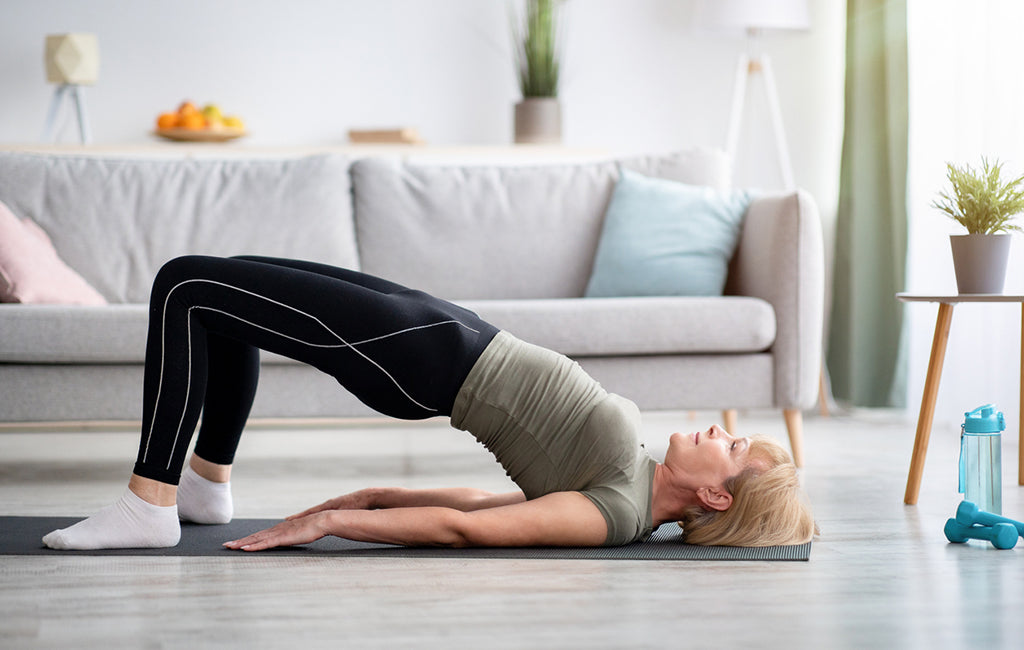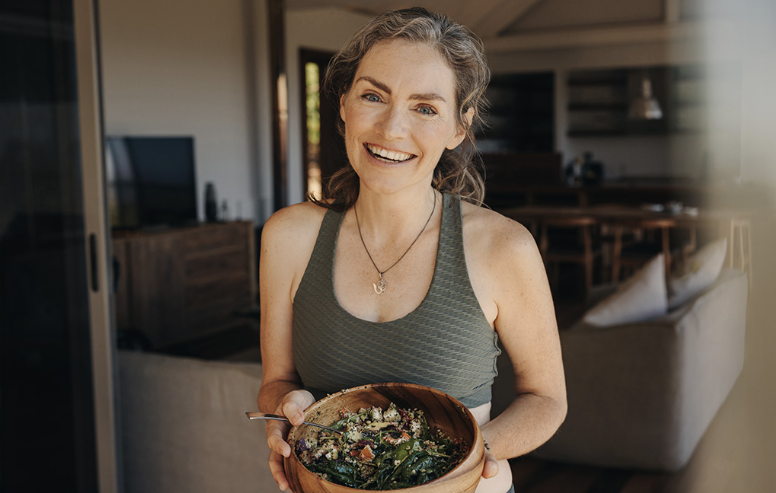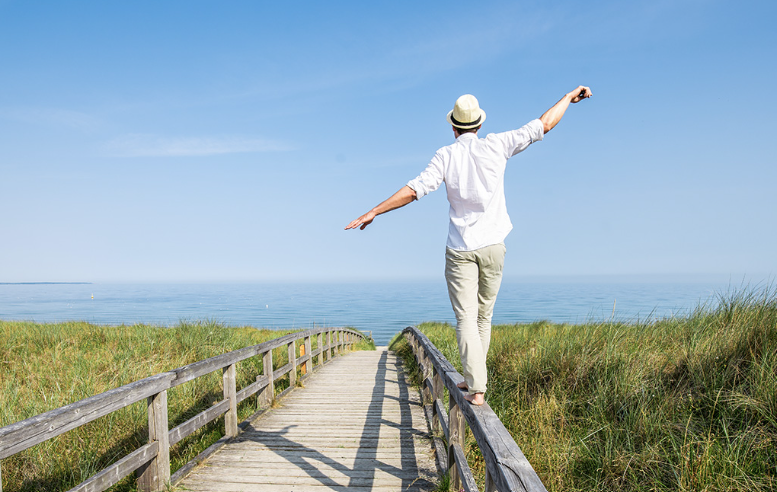
There are countless ways you can tweak your lower back.
Whether you’ve been lifting more weight at the gym, moving furniture around your house or sitting in a cramped seat during travel, the muscles surrounding your lumbar spines are particularly prone to strains.
The good news? Yoga moves can help release tension in your hips and spine, often guiding your lower back towards better health. You don’t have to be as flexible as Gumby to experience the benefits of yoga moves. In this short guide, we’ll cover the basics of yoga stretches for lower back health. Afterwards, you’ll be able to use yoga for lower back pain, yoga for sleep and more.
Yoga Helps You Listen to Your Body
Below, we’ll recommend several specific relaxing yoga poses for unlocking the hips and mobilizing the lower back. But before we get started, it’s important to emphasize the overall goals and techniques of yoga so that you can get the most out of your yoga exercise.
- Yoga is an opportunity for inner listening. We’ve all seen magazine covers featuring gravity-defying handstands and out-of-this-world backbends. But physical poses (asana) are just one of the eight limbs of classical yoga. Practices like breath work, meditation and asana all share one ultimate goal — helping people connect more deeply with themselves. As you’re practicing, look for opportunities to notice what helps your lower back and poor posture (and what doesn’t).
- If it hurts, don’t do it. Every body is different, as is every cranky lower back! The pose that brings you sweet relief might actually make things worse for your uncle or best friend. A deep, juicy and satisfying yoga exercise can certainly suggest you’re headed in the right direction. But if you start to feel aching, tingling, numbness or serious pain, back off!
- Move your focus beyond the back. A well-rounded yoga practice helps you warm up and stretch your entire body. Only have five minutes to focus on your back? That’s fine. But back issues can often stem from issues in the feet, hips and lower body. Likewise, a supple neck, shoulders and upper spine can help take pressure off your lower back and help your poor posture. For best results, try out a practice that gently addresses all major muscle groups or one that targets a specific area — like yoga for neck pain.
Set the Stage to Unwind Tension
While you can theoretically practice yoga anywhere, people with lower back issues will get the best benefits when they’re well-prepared with a yoga mat, one or two yoga blocks and a blanket.
Remember, the important thing isn’t what your yoga pose looks like but how it feels in your body.
Besides these props, it’s important to arrive on your mat relaxed and ready to pay attention to your body for the yoga sequence. Remember, the important thing isn’t what your yoga pose looks like but how it feels in your body.
To let go of your day and become present, try out one of the following to set the stage for your yoga sequence:
- Scent your space – Ever wonder why a yoga teacher often starts class by lighting candles or using a smudge stick? Sage, lavender and other soothing botanical aromas are thought to help us relax and unwind for great yoga postures. Even if you don’t notice an effect, at least your space will smell good!
- Take CBD – CBD can invite relaxation and soothe post-exercise inflammation. If you’re tense or inflexible, a CBD oil product can help ease you into the practice and reduce the likelihood that you’ll feel sore afterward.
- Declutter – You can do yoga next to your laundry pile, but do you really want to? Taking a few minutes to clean up your space can also clear your mind for great yoga postures.
Warm Up by Experience Level
Now that you’ve set the stage, it’s time to start moving.
But if you try to stretch your back and hips before the core muscles are warmed up, your body will inevitably complain.
Before going into deeper stretches, choose a warmup that includes other muscle groups, helping you achieve the potential whole-body benefits of yoga.
If you’re brand new to yoga, you might want to start off with a gentle routine. But if you’re a seasoned yogi, adjusting your warmup to protect your lower back can make all the difference.
Choose from the following warmup options:
- Beginner’s warmup – On your knees, practice cat/cow (alternating between a rounded and arched spine) for two minutes. Then, flex the spine laterally for one more minute (looking over your shoulder at your tailbone). Finally, tuck your toes and press back into downward dog (using a prop under your wrists if needed). Breathe in and out for 10 breaths, pedaling your heels to wake up your muscles.
- Intermediate warmup – Are you already an avid yoga enthusiast? Start your practice with five to eight sun salutations. While you’re nursing your lower back, avoid doing upward-facing dog. Instead, modify your vinyasa by pressing into a low cobra, lowering yourself back down and pushing into downward dog.
Unlock Your Hips
Your hip muscles connect your back to your lower body. A lack of mobility in the hips can place added strain on your lower back in walking, sitting and other daily activities.
If you experience soreness in your lower back, it can be helpful to start with gentle hip-opening postures like the following:
- Child’s pose – After completing your warmup, sit with your feet together, your knees apart and your seat on your ankles (if needed, add a block or blanket for support). Then, crawl your arms forward, finding a comfortable resting place with your forehead on the floor or on a block. Tuck your tailbone and breathe deeply into your hips and lower back for 10 breaths. This should be one of the most relaxing yoga poses.
- Supported squat – Come to upright and change the position of your blocks. Sit on a block (any setting) and spread your knees wide apart. Plant your feet firmly on the ground and breathe into your inner thighs for 10 breaths.
- Low lunge – Perform a knee-down lunge. Place your back knee on a blanket or fold your mat for added comfort. Depending on your hip flexibility, you might choose to move your hips forward in space, creating a deeper stretch along your back hip. Hold for 10 deep breaths on both sides.
- Reclined pigeon (figure four pose) – Lying on your back, bring your knees into your chest. Bend your right knee so that your ankle crosses the left thigh (creating the shape of the number four). Pull your knees into your chest as much as you can while keeping your lower spine firmly on the floor. Hold for 10 breaths, switch sides and repeat.
Stretch and Strengthen Your Back
After giving your hips some much-needed TLC, continue your work on the lower spine with the following yoga poses for back pain.
- Sphinx pose – Lie on your belly. Then, press up into the sphinx by placing your elbows under your shoulders and your forearms in line with your body. Gaze forward (not up). Breathe deeply into your chest and upper spine for 10 breaths.
- Bridge – Lowering from sphinx, turn over onto your back. Place your knees under your ankles and your arms on the floor alongside your body. Press into your arms and feet to bring your pelvis up into the air (keeping your hips level with your knees). Tuck your tailbone and breathe deeply for 10 breaths. If needed, use a block underneath your pelvis to support the pose.
- Spinal twist – Lower back to lying and extend both legs on the earth. Pull your right knee into your chest, then use your arms to guide it across your body, lowering it to the left. Place your knee on the earth or a block. Extend your arms in a T position and breathe deeply for 10 breaths. Switch sides and repeat on the left.
- Seated forward fold – Roll up into a seated position. With your knees comfortably bent, fold forward and bring your fingertips towards your calves or toes. If desired, rest your head on a block. Breathe deeply into your low back.
-
Savasana –Traditional yoga practice concludes with savasana, or the corpse pose. This usually means lying on your back, although people with lower back issues may find it more comfortable to bend their knees or roll into the fetal position on their sides. Whatever your final resting pose, use it as an opportunity to check in with your body and observe the changes to your lower back. This is also a great practice when using yoga for sleep, as it helps promote relaxation.
Zebra CBD For Yoga and Lower Back Support
Yoga is all about restoring balance to the body by stretching overused muscles, strengthening those that are underutilized and bringing attention and awareness to how you feel in the present moment.
For an extra helping hand at balance, try adding CBD to your yoga routine. Since CBD can help support homeostasis and soothe soreness, taking CBD before you practice can drop you deeper into your body.
As an added bonus, CBD’s own potent properties can help you find more comfort and ease in your lower back. Here at Zebra CBD, we offer high-quality CBD products that all come with a Label Accuracy Guarantee™.
If you’re looking to enhance your yoga routine and reduce your discomfort, then you’re in the right place.
Source:
Spine Health. Causes of Lower Back Pain. https://www.spine-health.com/conditions/lower-back-pain/causes-lower-back-pain
Yoga Journal. Get to Know the 8 Limbs of Yoga.https://www.yogajournal.com/practice/beginners/beginner-faqs-why-yoga/eight-limbs-of-yoga/
Ortho Virginia. How to Tell the Difference Between Hip and Lower Back Pain. https://www.orthovirginia.com/blog/how-to-tell-the-difference-between-hip-and-lower
Women’s Health. 10 Yoga Poses That’ll Ease Lower Back Pain and Open Up Tight Hips. https://www.womenshealthmag.com/fitness/g31228950/yoga-stretches-for-lower-back-pain/









